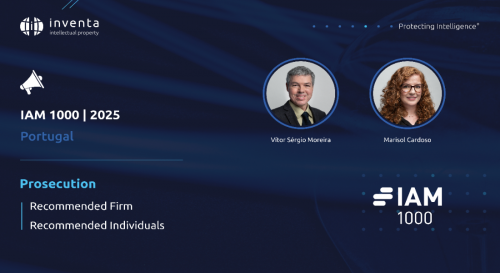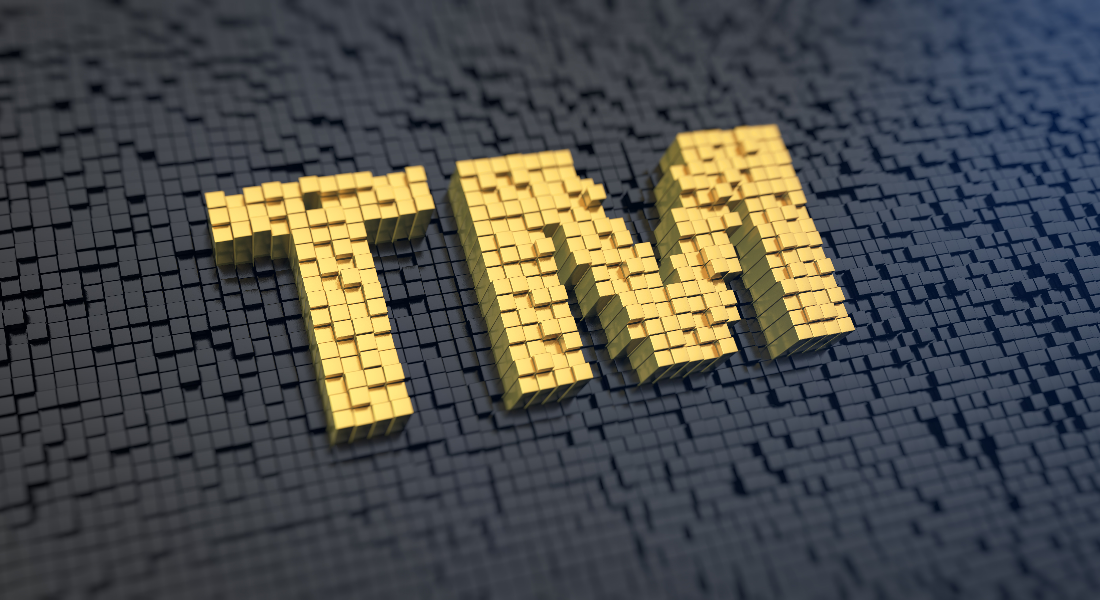
The elimination of the “graphical representation” requirement and its effect on non-traditional EU trademarks
The current European Union (EU) Regulation (Regulation (EU) 2017/1001 of the European Parliament and of the Council of 14 June 2017 on the European Union trade mark) on EU trademarks entered into force on the 1st of October, 2017. One of the major modifications introduced by that Regulation was the elimination of the graphical representation requirement of trademarks. This requirement was held responsible for being an obstacle to the registration of non-traditional trademarks.
The aim of this article is to analyze the effect of this change on non-traditional trademarks registrations in EU.
Non-traditional trademarks
Article 4 of the EU trademark Regulation provides that “An EU trade mark may consist of any signs, in particular words, including personal names, or designs, letters, numerals, colours, the shape of goods or of the packaging of goods, or sounds (...)”. This means that non-traditional trademarks can be registered in the EU.
A non-traditional trademark may be defined as any trademark that cannot be considered a traditional trademark. Traditional trademarks are word marks, figurative marks and word marks with figurative elements. Non-traditional trademarks are any other trademarks. Examples of non-traditional are 3D or shape, hologram, motion, multimedia, olfactory / taste and sound trademarks.
According to the European Union Intellectual Property Office (EUIPO)’s database there are currently (October 6, 2020) 11.177 non-traditional trademarks if searched by all status and 5.613 non-traditional EU trademark registrations currently valid, being 4.999 of them 3D or shape trademarks.
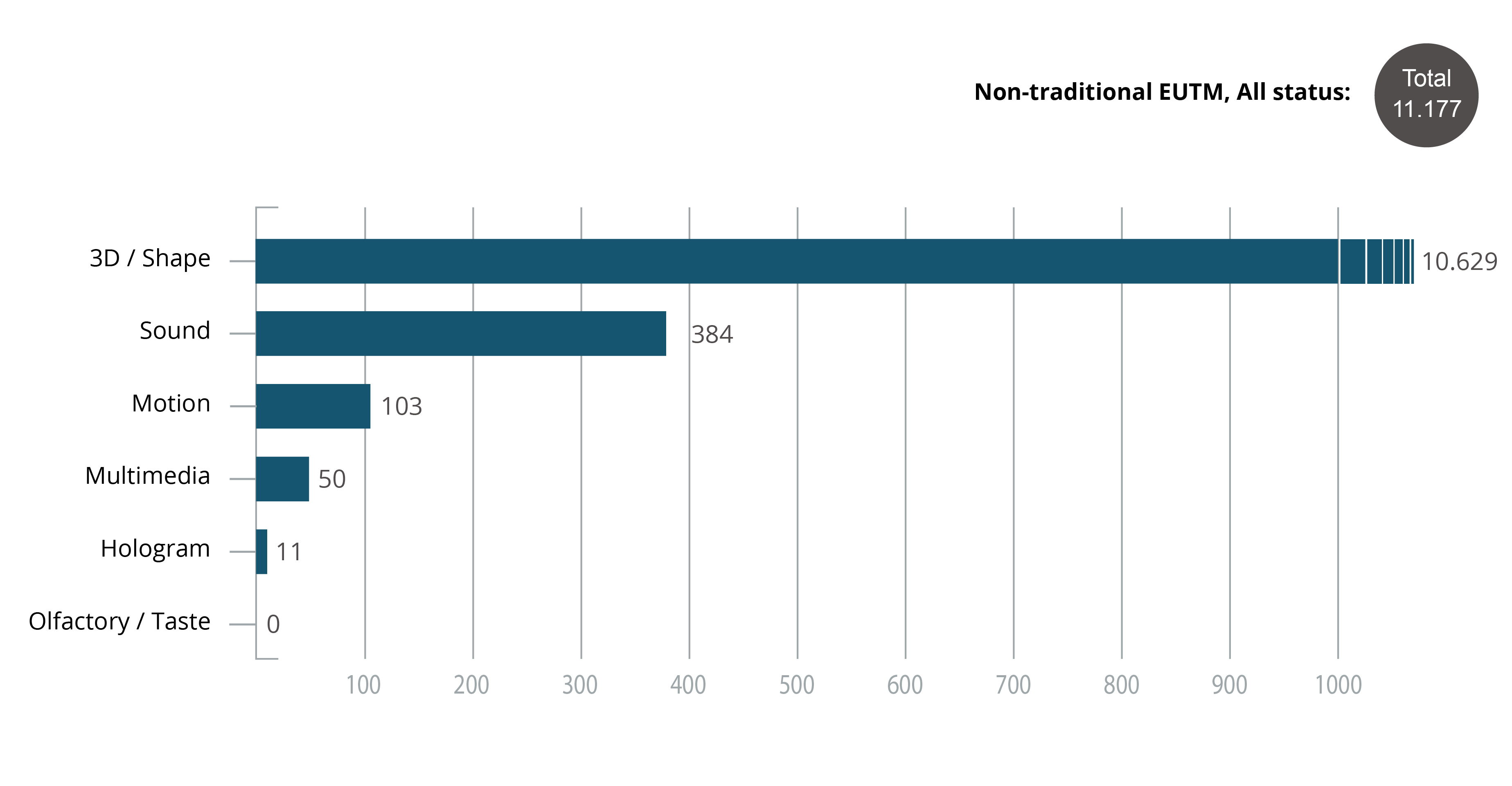

The “graphical representation” requirement
Prior to the 1st of October, 2017, Article 4 of the EUTM Regulations then applicable provided as follows: “A Community trade mark may consist of any signs capable of being represented graphically (...)”. This meant that any sign had to be necessarily represented in one specific way: graphically. Any other way of representing the sign was not allowed. For example, sound marks could not be represented trough a MP3 file nor a multimedia mark be represented trough a MP4 file.
Whatever the type of sign, the representation had to be graphic. This was not problematic for signs that are apprehended by vision and are static, like 3D or shape signs and holographic signs. These signs, despite being non-traditional, can easily be graphically represented. However, for signs that are apprehended by other senses than vision, like olfactory, taste and sound signs the graphic representation was difficult or impossible.
Applicants managed to fulfill this requirement in what sound signs are concerned, by filing, for example, musical scores. However, for sounds that were not music, graphical representation was very difficult, if not impossible, as, for example, sound spectrograms were not admitted. This was because not only the representation had to be graphic, it also had to be clear, precise, self-contained, easily accessible, intelligible, durable and objective” (ECJ decision in Sieckmann V. Deutsches Patent und Markenamt, C-273/00). Mere descriptions were not sufficient as well.
not only the representation had to be graphic, it also had to be clear, precise, self-contained, easily accessible, intelligible, durable and objective
The new requirement
The current EUTM Regulation provides in Article 4 that any sign can be a registered trademark in EU if it is able of “(b) being represented on the Register of European Union trade marks (‘the Register’), in a manner which enables the competent authorities and the public to determine the clear and precise subject matter of the protection afforded to its proprietor.”
As stated in recital 10 of EUTM Regulation, a “sign should be permitted to be represented in any appropriate form using generally available technology, and thus not necessarily by graphic means, as long as the representation is clear, precise, self-contained, easily accessible, intelligible, durable and objective.” This criteria is expressly provided for in Article 3 (1) of the Implementing Regulation. This means that the goal of eliminating the graphical representation requirement was to allow the use of any technology that is able to provide a sufficient representation of the sign for which protection is sought. The sufficiency of the representation will still be assessed with the criteria adopted by the ECJ in Sieckmann decision. The difference is that the representation does not have to be graphical.
The aim was to increase legal certainty and reduce objection rate for formality objections.
Currently, there are several technological means available for applicants. 3D and shape signs can be represented with JPEG, OBJ, STL or X3D files, sound signs can be represented by JPEG or MP3 files, motion sand holographic signs can be represented with JPEG and MP4 files, and multimedia signs can be represented with MP4 files.
However, not all non-traditional signs were significantly favored with this change. Olfactory and taste signs are currently not acceptable. The EUIPO determines that the current state of technology does not allow for these types of signs to be represented in a clear, precise, self-contained, easily accessible, intelligible, durable and objective way. Additionally, the Implementing Regulation does not allow the submission of samples for representing smells or tastes.
The new requirement and the changes on non-traditional trademarks
Three years have now passed since the elimination of the graphical representation requirement. In this point the changes produced by that legal modification on the number non-traditional trademarks filed and granted will be stressed.
Since the number of olfactory and taste EUTM, as already referred above, is zero, these will not be addressed, further than the conclusion that this legal modification did not produce any effects on these types of non-traditional trademarks.
Comparison of all status non-traditional and traditional trademarks
The information presented below is a comparison of two different periods: the two years immediately previous to October 1, 2017 and the two years immediately subsequent the October 1, 2017. So, the periods are from October 1, 2015 to October 1, 2017 and from October 1, 2017 to October 1, 2019.
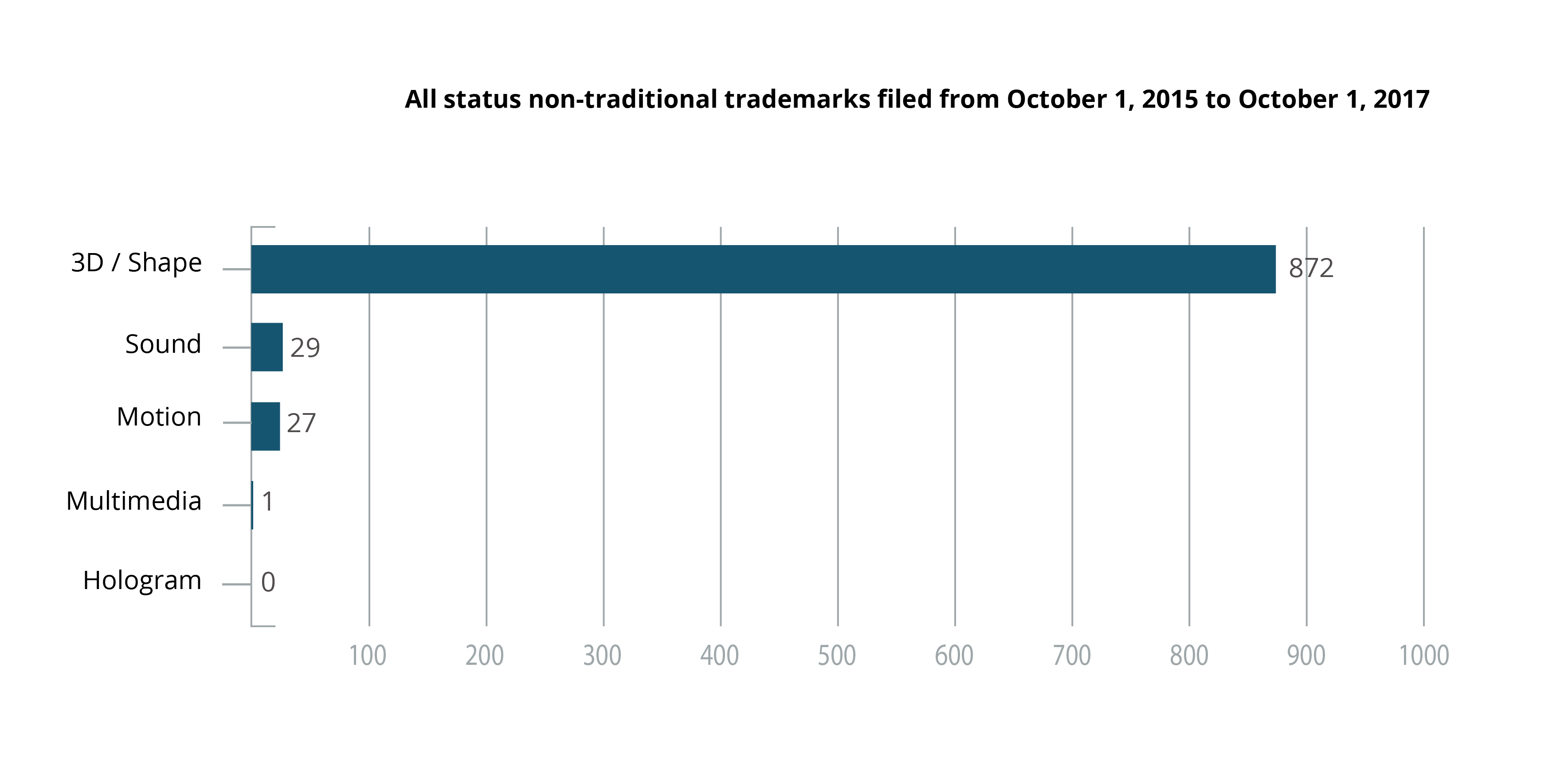
The first conclusion that can be taken from this graphic is that no hologram trademark applications were filed in these two years prior to October 1, 2017. Motion and multimedia trademarks before October 1, 2017 were not categorized as such, but as “others”. A search was conducted in the “others” type of trademark and motion and multimedia trademarks were identified consulting the descriptions of the signs.
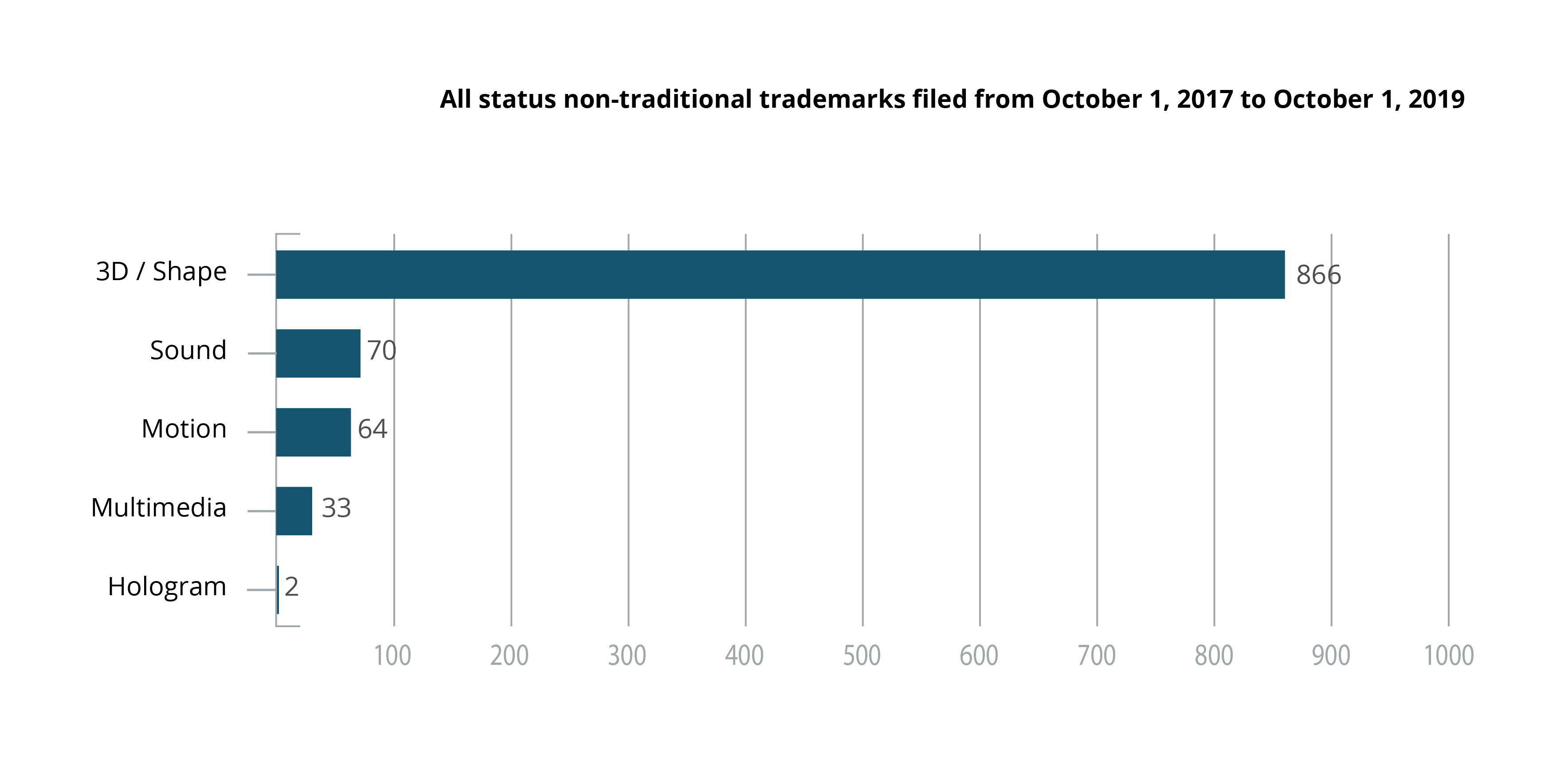 Comparing these two periods it is possible to conclude that the volume of 3D applications did not changed significantly. Hologram trademarks remain almost nonexistent. The major changes occurred regarding motion, multimedia and sound trademarks. Motion and sound trademark applications more than doubled and multimedia trademark applications grew 33 times, from one to 33.
Comparing these two periods it is possible to conclude that the volume of 3D applications did not changed significantly. Hologram trademarks remain almost nonexistent. The major changes occurred regarding motion, multimedia and sound trademarks. Motion and sound trademark applications more than doubled and multimedia trademark applications grew 33 times, from one to 33.

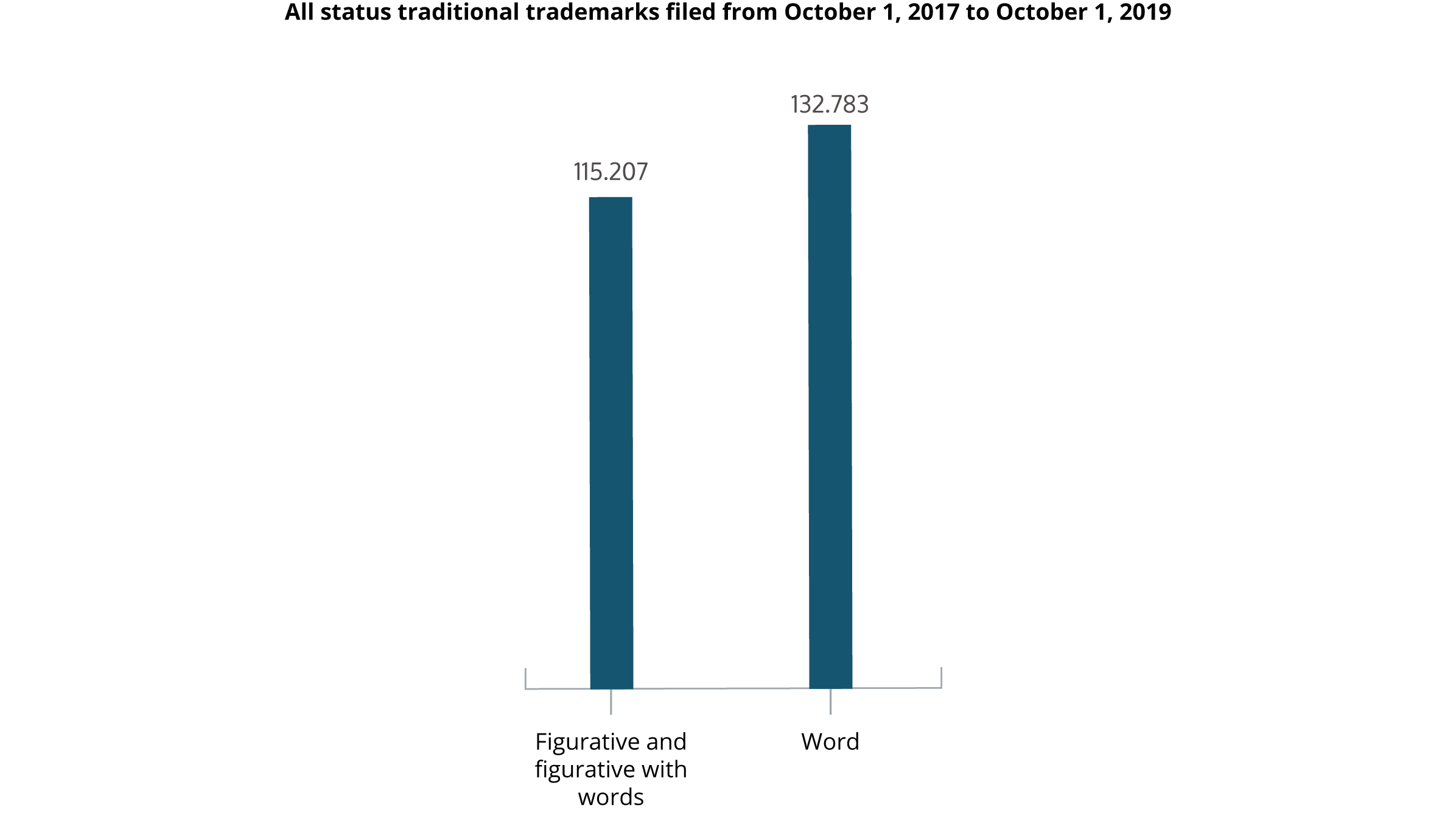
Comparing these two graphics it’s obvious that traditional trademarks did not grow as much as non-traditional trademarks. However, it also evident that non-traditional trademarks represent a very little fraction of all trademarks filed.
Comparison of granted non-traditional and traditional trademarks
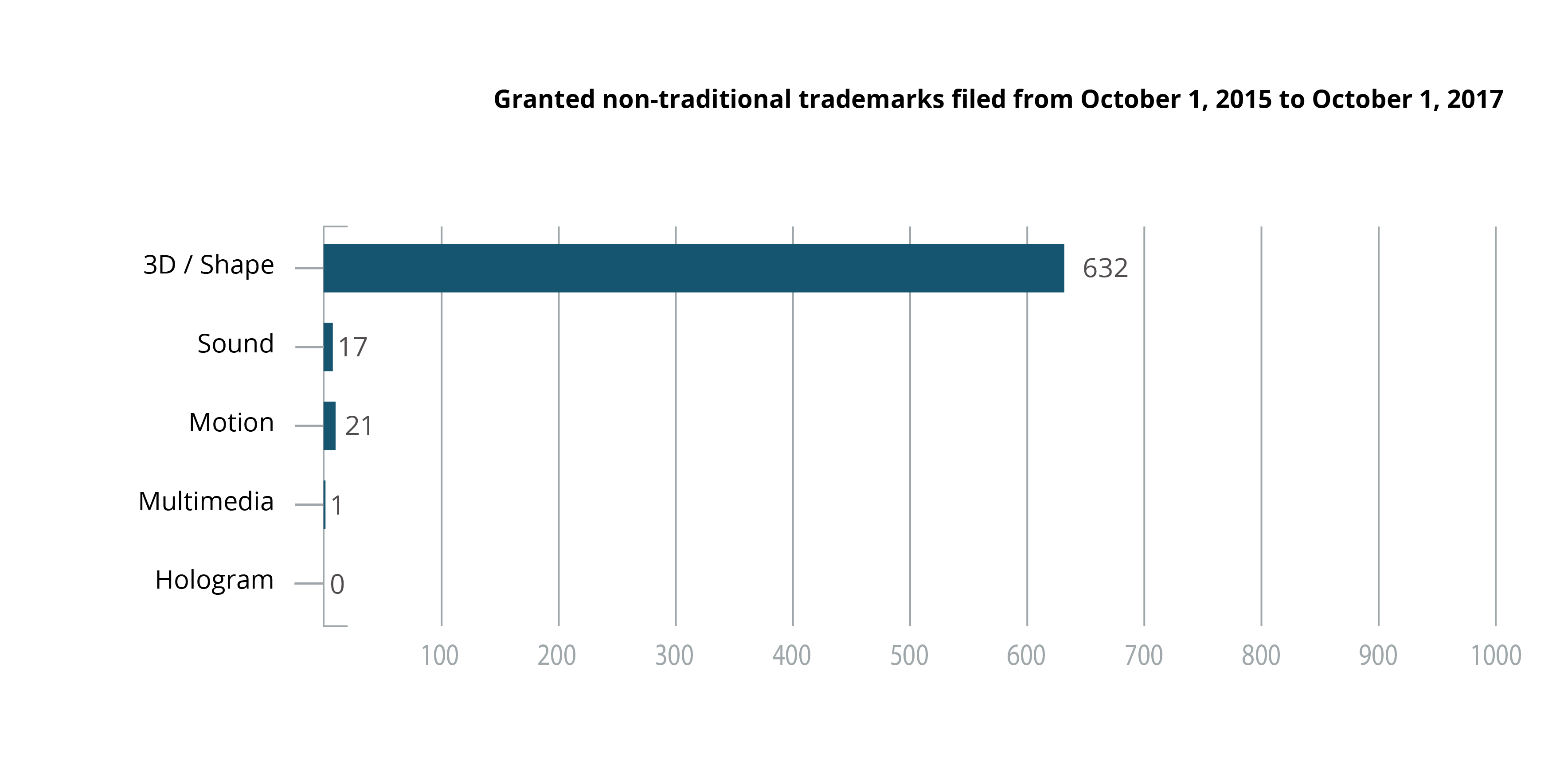
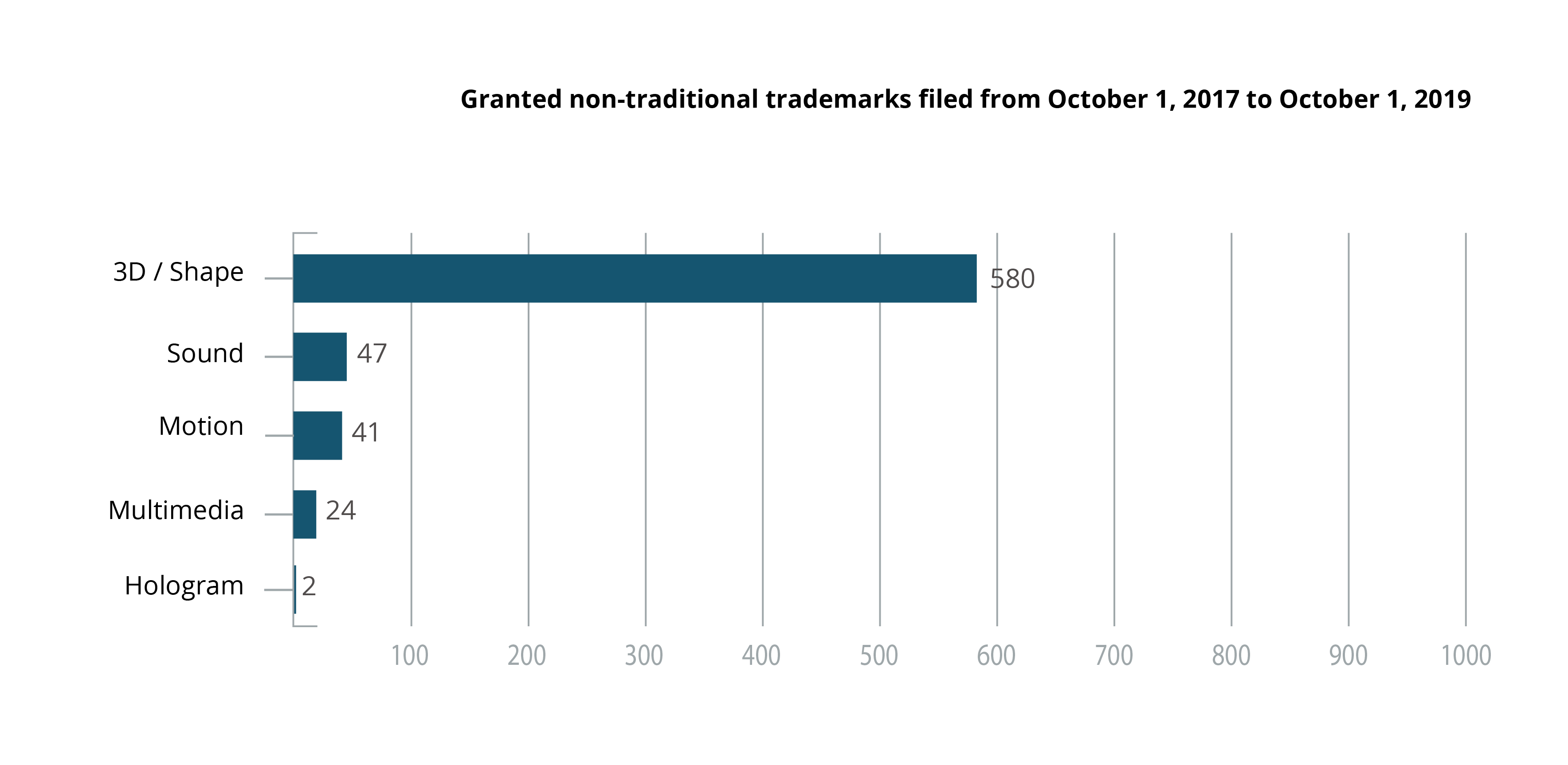
Comparing these two graphics with graphics of all status non-traditional trademarks, it’s is possible to conclude that this legal change did not have a significant effect on the granting rate of non-traditional trademark applications.
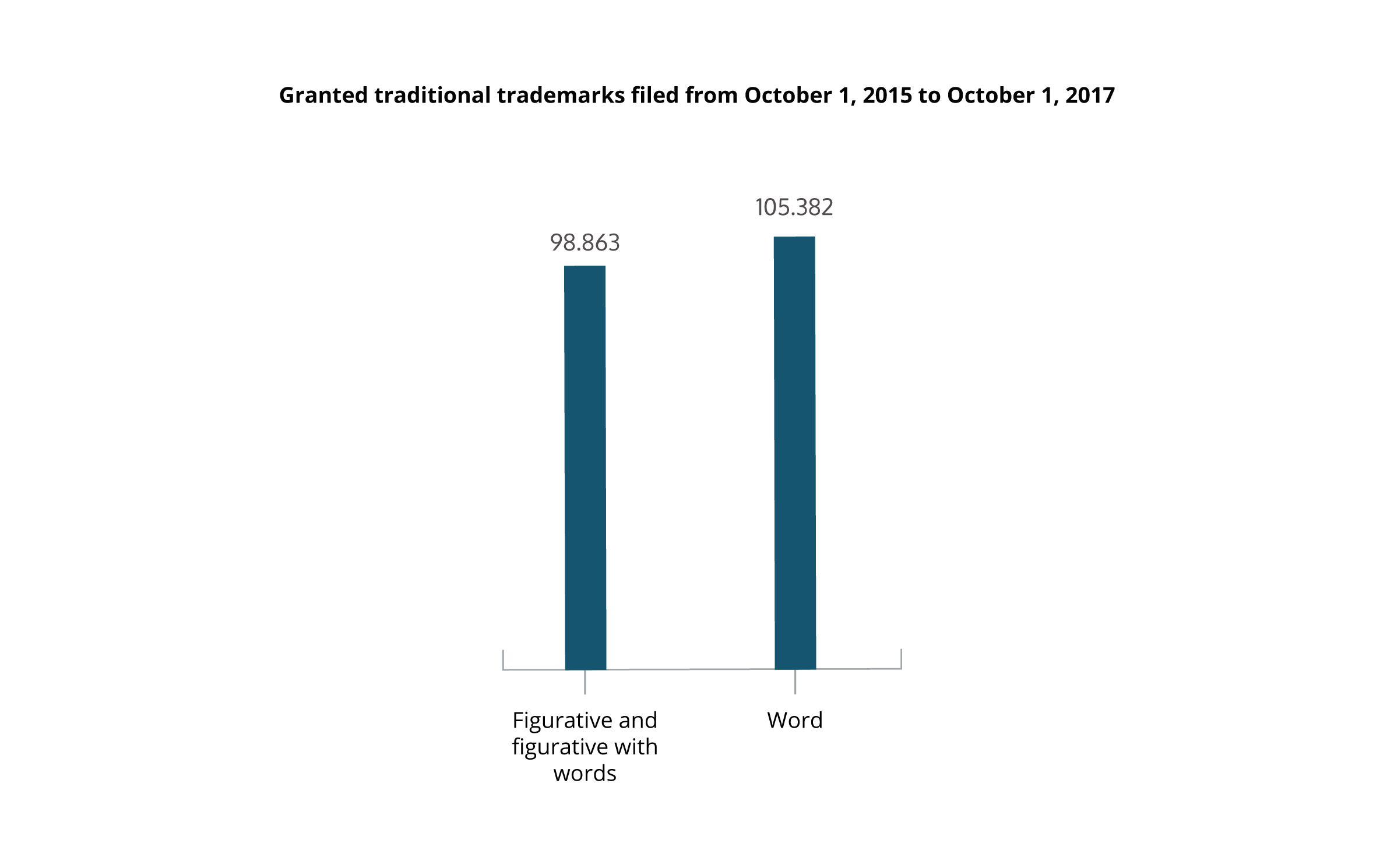
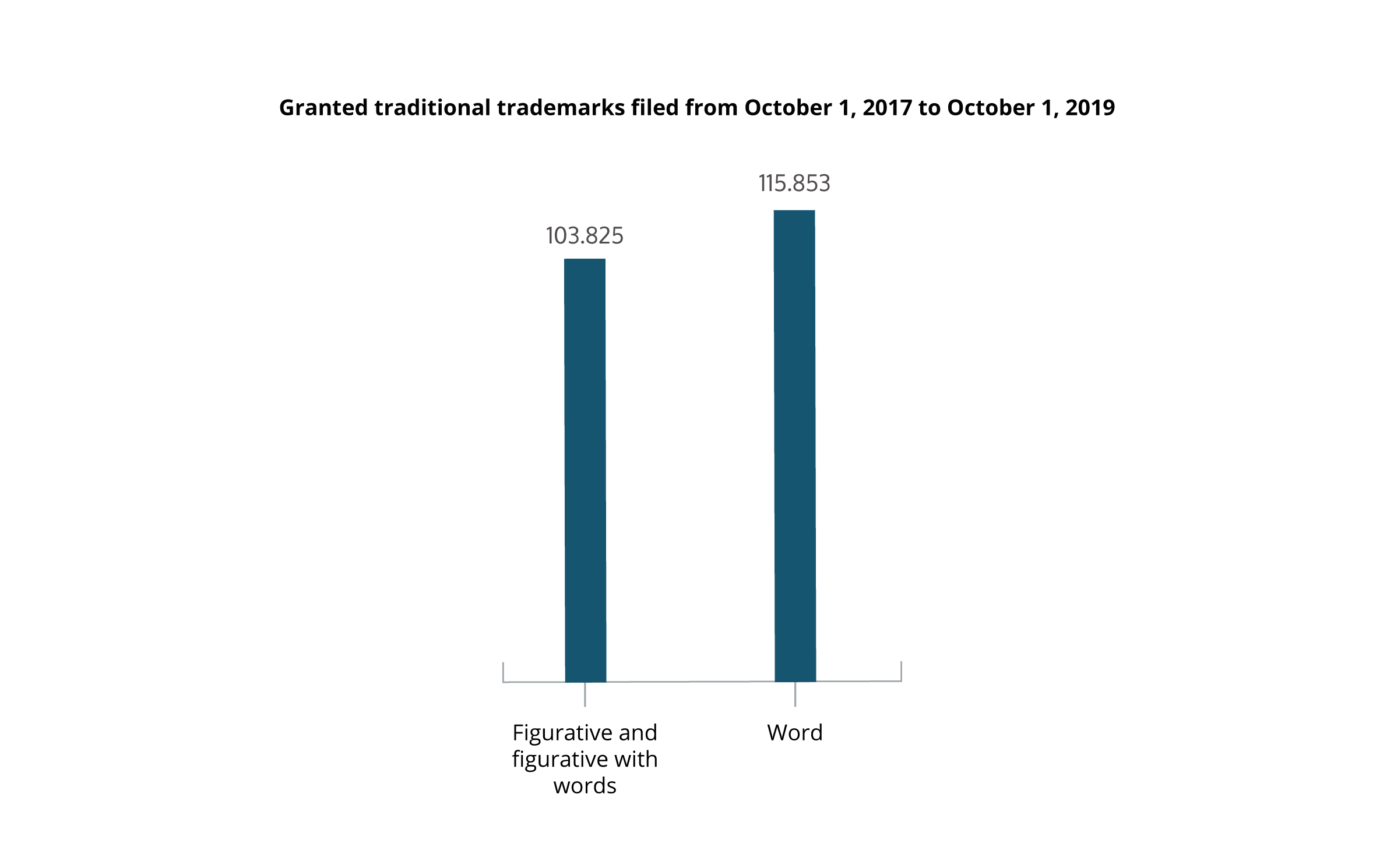
Comparing the above graphics is also possible to conclude that, before and after the legal change, the granting rate of traditional trademarks is higher than that of the non-traditional trademarks.
Conclusions
The “graphical representation” requirement was held as an obstacle to the registration of non-traditional trademarks. It is true that after its elimination from the EUTM Regulation several types of non-traditional trademarks as motion and sound more than doubled and that audiovisual trademarks grew more than 30 times. It seems that more than facilitating the granting of registrations of non-traditional trademarks the legal change facilitated the filing of these applications, specially for sound, motion and multimedia signs, as the granting rate, contrary to applications volume, did not see significant change.
However, it is evident that despite the high increase in percentage of the number of non-traditional trademark from one period to the other, the volume of non-traditional trademarks remain low. Taking into account the studied period, the average of sound trademark registrations granted by month is approximately 2 and 1 for multimedia trademarks.
* The information presented in the charts above is freely available for consultation on EUIPO’s database. The consultation occurred on October 6, 2020.
This article was originally published in China IP Magazine.
Lista de Territórios
Não existem resultados para a sua pesquisa.
- África
- África do Sul
- Angola
- Argélia
- Benin
- Botsuana
- Burkina Faso
- Burundi
- Cabo Verde
- Camarões
- Chade
- Comores
- Costa do Marfim
- Djibuti
- Egito
- Eritreia
- Eswatini (Suazilândia)
- Etiópia
- Gabão
- Gâmbia
- Gana
- Guiné
- Guiné-Bissau
- Guiné-Equatorial
- Lesoto
- Libéria
- Libia
- Madagáscar
- Maiote
- Malaui
- Máli
- Marrocos
- Maurícias
- Mauritânia
- Moçambique
- Namíbia
- Níger
- Nigéria
- Quénia
- República Centro-Africana
- República Democrática do Congo
- República do Congo
- Reunião
- Ruanda
- Saara Ocidental
- São Tomé e Principe
- Seicheles
- Senegal
- Serra Leoa
- Somália
- Sudão
- Sudão do Sul
- Tanzânia
- Togo
- Tunísia
- Uganda
- Zâmbia
- Zanzibar
- Zimbábue
- África (OAPI)
- África (ARIPO)
- Mais Territórios
- Macau
- Maldivas
- Portugal
- Timor Leste
- Marca da União Europeia (EUIPO)
- Marca Internacional (Sistema de Madrid)
- Patente Europeia (IEP)
- Tratado de Cooperação em matéria de Patentes (PCT)


